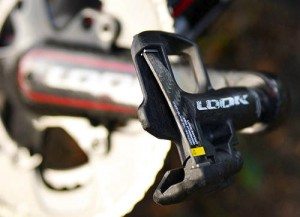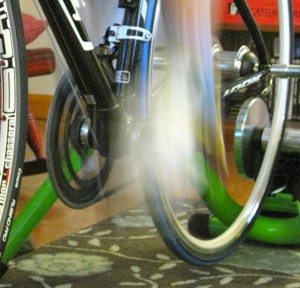Have you ever watched a pro cycling event like the Tour de France and marveled at how man and machine are almost one being? Isn't it remarkable how smoothly and efficiently each rider can propel their machine forward at speeds that make us mere mortals raise our eyebrows in amazement? Have you then compared them to some of the folks on your local group rides and seen the night and day difference? Maybe you are one of those riders who resembles a semi truck as opposed to a Ferrari, and you want to change that.
 You're probably worried that "I can't change that, those guys are gifted." Well, yes, that is true to some extent. Those guys spend their entire lives training and racing, and the vast majority of them are genetically gifted with high VO2 max and incredible natural ability. But you can still improve your pedaling technique, which will put you on the path to being more efficient and stronger on the road. And it won't cost your entire training week to accomplish, either.
You're probably worried that "I can't change that, those guys are gifted." Well, yes, that is true to some extent. Those guys spend their entire lives training and racing, and the vast majority of them are genetically gifted with high VO2 max and incredible natural ability. But you can still improve your pedaling technique, which will put you on the path to being more efficient and stronger on the road. And it won't cost your entire training week to accomplish, either.
Spin, don't stomp
Cycling is about smooth, fluid, efficient movements, and you should keep that in mind as you ride. You should never be stomping on the pedals like you're walking up stairs (unless the terrain really is so steep that the only way to get up is to "walk" your way up.) Concentrate on keeping your legs spinning in a smooth circle, and try to keep your cadence up around 90 RPM. This will allow your muscles to work fluidly and keep your body burning oxygen (aerobic energy production) versus burning glycogen anaerobically. Not only is aerobic respiration far more efficient, it is almost indefinitely sustainable (utilizing fat as the primary fuel vs using glycogen as the primary fuel.) But how do you work on the spin? How can you perfect that fluid movement that appears so effortless on the pro level? First, let's understand what happens during the pedal stroke.
 Dissection
Dissection
The pedal stroke can be broken down into roughly four parts: Top Dead Center, power phase, Bottom Dead Center and the recovery phase. It is important to note that different muscles activate during these different parts of the pedal stroke, and that a tradeoff happens between these muscles as the pedals are turned. Let's break it down via the chart at left and the description below:
- Starting at TDC (12 o'clock), the hip extensors (gluteal muscles primarily) will initiate the power phase
- Around 3 o'clock, the knee extensors (quadriceps) take over and contract until about the 5 o'clock position
- Around 4 o'clock, the ankle plantar flexors (gastroc and soleus, responsible for pointing the toes downward) take over until the pedal hits BDC, ending the power phase
- BDC (6 o'clock) has little to no activity, and the motion of the other leg helps to push the pedal through BDC
- Just after 6 o'clock, the ankle dorsiflexors (tibialis anterior) take over, beginning the recovery phase
- Around 8 co'clock, the knee extensors (hamstrings) begin to contract
- Around 9 o'clock, the hip flexors (psoas, sartorius and rectis femoris) finish the recovery phase
So now we have an idea of what happens during the pedal stroke, let's figure out how to make it all work more smoothly.
The best place to practice working on pedal stroke and technique is on the trainer (an even better, albeit potentially more painful option is a set of rollers.) Warm up for 10 to 15 minutes while pedaling in an easy gear. When you're muscles are loose and warmed up, stay in your small chainring and pick a gear you can turn easily at 80-90 rpm. We're ready for two drills specifically designed to smooth out your pedaling technique.
single leg drill
Unclip your left foot from the pedal and either rest it on the trainer or dangle it to the side, out of the way. Continue pedaling with your right leg, trying to maintain 80-90 rpm (shift to an easier gear if you can't manage the one you're in.) You'll probably notice a couple of jerky, choppy spots in the rotation that coincide with TDC and BDC. These are the areas you'll want to pay the most attention to. Focus on keeping steady pressure through the power phase, pulling backwards through BDC into the recovery phase and then pushing forward through TDC into the power phase again. When you get it right, you'll feel the pedal spin smoothly in a circle, and you'll hear a constant noise from the trainer/rear wheel.
Aim for 30 seconds on the right, put the left foot back in and spin easy with both legs for a minute, then click the right foot out and pedal single legged on the left for 30 seconds to complete one set. Do three sets, then spin 5 minutes easily and then do 3 more sets. Try to maintain a smooth constant pressure throughout all the intervals (it will get tougher as the sets build up.)
 Spin ups
Spin ups
Another excellent workout to consider are "spin ups." Warm up in an easy gear, pedaling 80-90 RPM and set your computer to display time and cadence. Once warmed up, start at 80 RPM and increase your cadence about 5 RPM every 10 seconds until you get hit 125 RPM. If you start to bounce around before you hit 125, hold it there and work on getting the form right before pushing the cadence up any further. Hold that 125 RPM (or the max cadence without bouncing) for 30-45 seconds more, or until your form deteriorates. When your 30-45 seconds are up, spin easily at 80 rpm for two to three minutes before starting the build up again. Repeat three times, focusing on your form and fluidity, but always remembering to keep from bouncing in the saddle.
What's the point?
One of the most important things to remember about these drills are that they are not intervals. You shouldn't be pushing a big gear or raising your heart rate too much. If you find your starting to work extremely hard, shift a couple gears easier and work on your form, not your fitness. Working these drills into your riding three times per week will help to smooth your pedal stroke out, and you can always make the duration of the drill longer as you get more proficient. After a few weeks of diligent work, you'll notice a difference in the fluidity of your pedaling when you're out on the road.
Questions? Comments? Leave them below and get the discussion started.
One thought on “Smoothing Your Pedal Stroke”
Comments are closed.